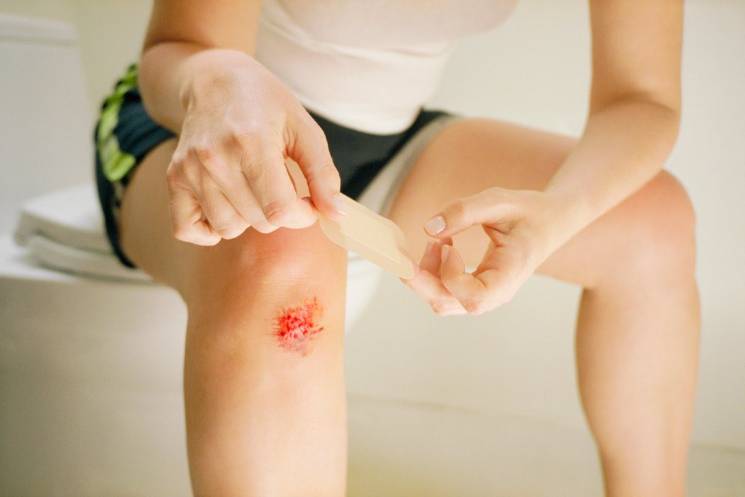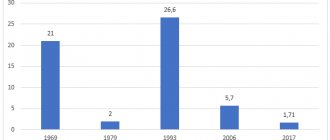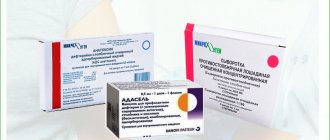Doctors often forget to provide tetanus prophylaxis to patients, which then serves as a reason for litigation. The rules for performing prophylaxis are regulated in Russia by order of the Ministry of Health of the Russian Federation dated May 17, 1999 N 174 “On measures to further improve the prevention of tetanus.” The order is quite voluminous; only extracts that relate to issues of emergency prophylaxis are listed below.
- Emergency prophylaxis of tetanus
- Immunological control for emergency prophylaxis of tetanus
- Prescription of drugs
- Active-passive prophylaxis of tetanus
- Contraindications
Emergency prophylaxis of tetanus
Emergency prevention of tetanus begins with primary surgical treatment of the wound and simultaneous specific immunoprophylaxis. Emergency immunoprophylaxis for tetanus should be carried out as early as possible and up to 20 days after the injury, taking into account the length of the incubation period for tetanus.
Emergency prophylaxis of tetanus is carried out when:
- frostbite and burns (chemical, thermal, radiation) of the 2nd, third and fourth degree;
- injuries in which there was a violation of the integrity of the skin and mucous membranes;
- abortions performed outside of hospitals;
- penetrating injuries of the gastrointestinal tract;
- gangrene or tissue necrosis of any type, long-term carbuncles, abscesses;
- childbirth outside of medical institutions (for example, at home);
- animal bites.
Note
<1> Instead of 0.5 ml of adsorbed tetanus toxoid, ADS-M can be used if vaccination against diphtheria with this drug is necessary. If the localization of the wound allows, it is preferable to introduce AS into the area where it is located by subcutaneous injection.
<2> Use one of the following drugs: PSCHI or PSS (it is preferable to administer PSCHI).
<3> For “infected” wounds, 0.5 ml of AS is administered if 5 or more years have passed since the last revaccination.
<4> The full course of AS immunization for adults consists of two vaccinations of 0.5 ml each with an interval of 30-40 days and revaccination after 6-12 months. the same dose. According to the abbreviated scheme, the full course of immunization includes a single vaccination with AC in a double dose (1 ml) and revaccination after 1-2 years with a dose of 0.5 ml of AC.
<5> Two vaccinations according to the regular immunization schedule (for adults and children) or one vaccination according to the abbreviated immunization schedule for adults.
<6> For “infected” wounds, PSCH or PSS is administered.
<7> All people who received active-passive prophylaxis to complete the course of immunization after 6 months. - 2 years old should be vaccinated again with 0.5 ml of AC.
<8> After the post-traumatic state has normalized, children should be vaccinated with the DTP vaccine.
Etiology and causes
The anaerobic gram-positive bacillus Clostridium tetani comes from birds, humans and herbivores. The pathogenic microorganism is located in the intestines of the carrier and enters the environment along with the feces of the diseased organism. It can enter the body of a healthy person through damaged skin or mucous membrane. Often these are wounds, abrasions, punctures, crushing from impacts, falls, etc. There is a high risk of infection if antiseptic rules are not followed when treating frostbitten or burned areas of the patient’s skin.
If, after entering the body, the pathogen finds suitable living conditions for itself, it begins to actively reproduce in a vegetative manner. The anaerobic space inside deep purulent wounds, punctures, etc., where there is no access to fresh air, is considered the most favorable for the incubation period of tetanus. During the process of life and reproduction, the rod secretes potent toxins tenatospasmin and tetanolysin. They have a negative effect on the nervous system and blood composition, complicate the work of the heart muscle and contribute to the destruction of tissue in the affected area. Under the influence of toxins, the peripheral nervous system produces characteristic tonic convulsions, which are often used to determine the fact of infection. The first symptoms of the disease may appear 1-2 months after infection, which depends on the number of pathogenic microorganisms that entered the body through a wound or damaged skin.

Immunological control for emergency prophylaxis of tetanus
In the absence of reliable information about vaccinations, the state of tetanus immunity is assessed immediately at the time of the patient’s treatment for injury. The scheme for choosing emergency prophylaxis is based on the results of determining the level of a specific antitoxin in the blood serum of a patient with trauma or on indirect criteria for the fact of vaccination against tetanus (age, gender, absence of contraindications, military service, etc.)
A blood volume of 0.2 ml sufficient for research can be obtained from a wound or simultaneously with taking blood from a finger for any clinical analysis. Blood is collected into a capillary or test tube, which is left at room temperature or in a household refrigerator for 15-20 minutes, after which the supernatant liquid over the red blood cells (serum) is used for serological studies.
When taking blood from a vein, a standard method of separating blood serum is used. The determination of tetanus antitoxin in the patient’s blood serum is carried out in the RPGA in accordance with the instructions for the use of diagnosticums. The minimum titer of tetanus antitoxin, indicating immunization, is 1:20.
Frequently asked questions about the disease
How to treat tetanus?
The basis of treatment is the immediate administration of tetanus toxoid serum or antitoxin to the patient, which removes the consequences of the toxic effects of pathogenic microflora. At the same time, anticonvulsant therapy and elimination of the consequences of damage to the peripheral nervous system are carried out, as well as stabilization of cardiac activity. All of the above manipulations are carried out in an intensive care unit.
Why is tetanus dangerous?
Hiding in the body and continuing to actively reproduce, the anaerobic bacillus Clostridium tetani may one day make itself felt with a convulsive syndrome, rapid heartbeat, and a sharp deterioration in condition. The listed symptoms will increase, aggravating the pathological condition of the patient. In the absence of immediate qualified treatment, the risk of death approaches 100%.
How long does it take for tetanus to appear?
The first unpleasant symptoms in the form of muscle numbness and cramps may appear several days, weeks or even a couple of months after the infection of the body. It all depends on the functioning of the immune system and the amount of infection that has entered the body. With timely vaccination, the disease can be asymptomatic or make itself felt with rare mild convulsions.
Prescription of drugs
The prescription of drugs for emergency immunoprophylaxis of tetanus is carried out differentially depending on the availability of documentary evidence of preventive vaccination or data from immunological monitoring of the intensity of tetanus immunity, as well as taking into account the nature of the injury.
No medications are administered
- children and adolescents who have documented evidence of routine preventive vaccinations, which are due to them by age, regardless of the time that has passed since the next vaccination;
- adults who have documented evidence of a full course of immunization no more than five years ago;
- people who have a titer of tetanus antitoxin in the blood serum above 1:160 according to RPGA (according to emergency immunological control), which corresponds to a titer above 0.1 IU/ml according to the biological neutralization reaction - PH (protective titer).
Only 0.5 ml of AC toxoid is administered
- adults who have documented evidence of a full course of immunization more than 5 years ago;
- children and adolescents who have documentary evidence of a course of scheduled preventive vaccinations without the last age-specific revaccination, regardless of the date of the last vaccination;
- persons who, according to emergency immunological control, have a tetanus toxoid titer in the range of 1:20-1:80 according to RPGA data or in the range of 0.01-0.1 IU/ml according to RN data;
- persons of all ages who received two vaccinations no more than 5 years ago, or one vaccination no more than 2 years ago; children from 5 months of age, adolescents, conscripts and those who have served a specified period in the army, whose vaccination history is unknown, and there were no contraindications to vaccinations.
Instead of 0.5 ml of AC, 0.5 ml of ADS-M can be administered if immunization with this drug is necessary.
Emergency prevention of tetanus is carried out in compliance with the following rules:
- Before administration, the ampoule with the drug is carefully examined. The drug should not be used in the following cases:
- – if there is no complete information about the drug on the label;
– if there is no label on the ampoule;
– in the presence of unbreakable flakes, sediment or foreign inclusions (fibers, burnt marks, etc.);
– if there are cracks on the ampoule;
– in case of improper storage of the drug;
– in case of expired medicinal product;
- immediately before administering the AS, the ampoule is shaken until a homogeneous suspension is obtained;
- When opening the ampoule, before and after the incision with a file, wipe it with sterile cotton wool moistened with alcohol. An opened ampoule of AS or PSS can be stored, covered with a sterile napkin, for no more than 30 minutes;
- drugs are drawn into a syringe from an ampoule using a long needle with a wide lumen. A different needle must be used for injection;
- the skin at the injection site is disinfected with 70% alcohol;
- After administering the drug, the injection site is lubricated with iodine or alcohol.
Severity
The disease can occur in one of the following forms:
- Mild when tonic convulsions are absent or observed in small quantities. This stage lasts about 5-7 days. This course of the disease is observed in previously vaccinated patients.
- Moderate course. Symptoms make themselves felt within 3-4 days: convulsions occur several times a day, the patient’s body temperature rises.
- Heavy current. Convulsions occur several times an hour, body temperature rises, tachycardia and intense sweating are noted.
- Very severe course. Convulsions occur every 5 minutes, tachycardia and frequent shallow breathing are noted. The condition is extremely dangerous and often fatal.
Tetanus does not form post-infectious immunity in the body, and there is a possibility of re-transmitting the disease. Direct routes of infection with tetanus from a sick person are impossible.
More often, the prognosis for severe cases of the disease is unfavorable - death, less often - the occurrence of a whole bunch of complications after exposure to potent toxins on the internal organs.
Active-passive prophylaxis of tetanus
AC should be administered in a volume of 1 ml, having previously read the instructions for the drug. At the same time, PSCH 250 IU must be injected into another part of the body; in the absence of PSCH, 3000 IU PSS must be injected. Before administering PSS, an intradermal test with horse serum diluted in a ratio of 1:100 is required to determine sensitivity to horse serum proteins (the ampoule is marked in red). An intradermal test cannot be performed if the victim was tested with 1:100 diluted anti-rabies gammaglobulin from horse serum for 1-3 days before the administration of PSS due to the need to administer anti-rabies gammaglobulin.
To perform the test, you need to use an individual ampoule, as well as sterile syringes with 0.1 ml graduations and a thin needle. The serum diluted 1:100 is injected under the skin into the flexor surface of the forearm in an amount of 0.1 ml. The reaction is monitored after 20 minutes. The test is considered negative if the diameter of the swelling or redness at the injection site is less than 1.0 centimeters.
The test is considered positive if the swelling or redness in diameter is 1.0 cm or more. If the skin test is negative, PSS (from an ampoule marked in blue) is injected subcutaneously in a volume of 0.1 ml. If there is no reaction after half an hour, you need to inject the remaining dose of serum with a sterile syringe. During this period, the opened ampoule with PSS should be covered with a sterile napkin.
Note : For people with allergic diseases and reactions to various allergens, as well as those who have previously received drugs containing horse serum (PSS and others) or heterologous gammaglobulins (anti-rabies, anti-encephalitis, etc.), it is best to resort to the administration of antihistamines before administering the main dose of PSS.
Persons with a positive reaction to intradermal injection of 0.1 ml of horse serum diluted 1:100 or who had a reaction to subcutaneous injection of 0.1 ml of PSS cannot undergo further administration of PSS.
Considering that after the administration of PSS and drugs that contain tetanus toxoid, particularly sensitive individuals may develop shock, each vaccinated person must be monitored medically for 60 minutes after vaccination. And the institution where people are vaccinated should be provided with anti-shock therapy in case of need.
Symptoms of the incubation and main periods in adults
After the action of toxins on the human body, the following are noted:
- the appearance of muscle pain;
- stiffness of the lower jaw muscles;
- a characteristic smile on the face with downturned corners of the lips;
- difficulty swallowing;
- spasms of the facial muscles, which gradually spread to the whole body, causing the patient to involuntarily bend in an arc.
Complications
A sudden onset of convulsive syndrome can cause fractures of bones and spine, rupture of tendons and muscle tissue. There is a high probability of consequences of damage to the heart muscle, heart attack, sepsis, pulmonary edema or pneumonia.
Are you experiencing symptoms of tetanus?
Only a doctor can accurately diagnose the disease. Don't delay your consultation - call
Contraindications to the use of specific means of emergency prophylaxis of tetanus
The main contraindications to the use of specific tetanus prophylaxis are:
- pregnancy (in the first half, the administration of AS (ADS-M) and PSS is contraindicated, in the second half - PSS);
- increased sensitivity to the appropriate prophylactic agent;
- in persons who had contraindications to the administration of AS (ADS-M) and PSS, the possibility of emergency prophylaxis with the help of PSCI is determined by the attending physician.
Alcohol intoxication is not a contraindication to emergency prevention.











